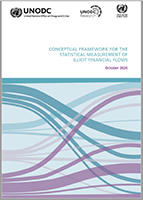
The Conceptual Framework for the Statistical Measurement of Illicit Financial Flows is a joint UNODC-UNCTAD publication. The UNCTAD-UNODC Task Force on the statistical measurement of illicit financial flows endorsed the conceptual framework as a basis for further work.
Illicit financial flows refer to activities considered as criminal offences, but also some behaviours related to tax and commercial practices. The International Classification of Crime for Statistical Purposes (ICCS)5 provides definitions of illegal activities generating IFFs.
The proposed framework identifies four main types of activities that can generate IFFs:
- Tax and commercial activities
- Illegal markets
- Corruption
- Exploitation-type activities and financing of crime and terrorism.
For each of these types, IFFs can generally emerge at two different stages:
- Illicit income generation, which includes the set of cross-border transactions that are either performed in the context of the production of illicit goods and services or generate illicit income for an actor during a non-productive illicit activity.
- Illicit income management, which refers to cross-border transactions that use illicit income to invest in financial and non-financial assets or to consume goods and services.
Illicit financial flows are multi-dimensional, comprising several different kinds of activities, including flows originating from illicit activities, illicit transactions to transfer funds that have a licit origin, and flows stemming from licit activity being used in an illicit way. Not all IFFs stem from illegal activity. For example, the indicator includes aggressive tax avoidance as an illicit financial flow, as it can be considered detrimental to sustainable development in many countries, even though such activities are generally not illegal.
In October 2019, the 10th session of the Inter-agency and Expert Group on Sustainable Development Goals Indicators (IAEG-SDGs), held in Addis Ababa, reviewed the methodological proposal and reclassified the indicator from Tier III to Tier II,6 meaning that the indicator is conceptually clear and has set out internationally established standards, although data are not yet regularly produced by countries.
This document further details the conceptual framework for measuring IFFs. The framework and specific measurement methodologies are tested in ongoing and new pilot activities. The methods in relation to selected illegal markets have been tested in Latin America as well as at the subregional level for selected activities (wildlife goods and drug trafficking). Preliminary findings show the feasibility of the developed measurement approaches.
Related
Topic

Program
Projects
- Defining, estimating and disseminating statistics on illicit financial flows in Africa
- Developing indicator on illicit financial flows and monitoring them in Latin America
- Statistics and data for measuring illicit financial flows in the Asia-Pacific region



